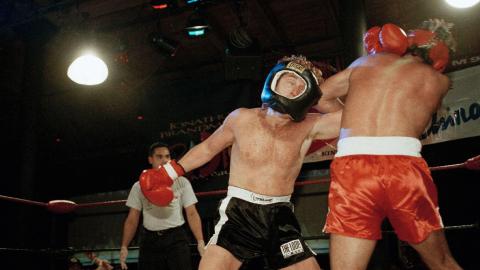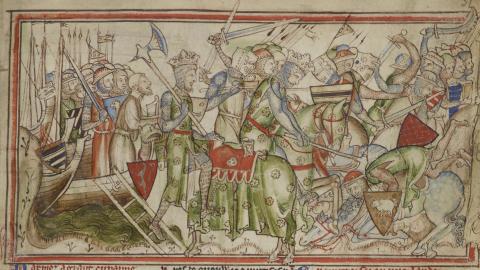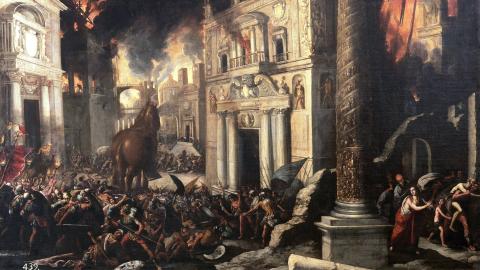Scotland’s Greatest Victory Over the English
When it comes to international rivalries, few are as salty as the one between Scotland and England. Rivalry isn’t even the right word, because that implies a kind of grudgingly respectful competition. Really, it’s more accurate to say that Scots just don’t like the English very much.
Yes, that’s a gross generalisation, but it’s pretty accurate as gross generalisations go. Al Murray finds out for himself in his new series, Why Does Everyone Hate the English? where he delves into Sottish culture and cuisine, including a takeaway snack which clocks up 5,000 calories. He also finds out the real deal on that William Wallace, who became a world famous icon of heroism and rebellion thanks to an Australian actor with a dodgy Scottish accent and a historically inaccurate kilt.
Yes, to say Mel Gibson’s Braveheart is a tad disloyal to the truth is like saying Scots are a tad displeased when England do well in major football tournaments. Remember Braveheart’s great love interest, Isabella of France? In real life, she was still a young child at the time of William Wallace’s death. Mel’s great kilt? This kind of clothing wasn’t actually worn until several centuries later. Imagine if Shakespeare in Love featured Joseph Fiennes swanning around in a 1940s suit and tie – that’s exactly how absurd Braveheart looks to scholars of Scottish history.
An almighty mess
The real story of the Scottish wars of independence, and that troublesome chap called William Wallace is far more interesting than the movie version. For example, all the bloodshed and strife could have been averted if one little girl hadn’t inconveniently died at the worst possible moment.
She was Margaret, Maid of Norway, the child heir to the Scottish throne. Her grandfather, King Alexander III of Scotland, had no living children on the fateful night he made the brilliant decision to go riding his horse across the craggy Scottish coastline in the dead of night. The king fell and broke his neck, and the mantle was passed to young Margaret, over in Norway.
Which would have been great, except Margaret herself died while sailing over to Scotland. An almighty mess ensued, with different claimants bickering over who should be next in line for the crown. In stepped Edward I of England (yes, the bad guy from Braveheart), who threw his weight behind an aristocrat called John Balliol.
'For two days streams of blood flowed… so that mills could be turned round by the flow of their blood.’
Balliol duly became king, but was effectively a puppet of Edward, who started sticking his oar into Scottish politics and basically started treating the kingdom as his own. This didn’t go down too well with the Scots, who eventually forged an alliance with France. An incredibly indignant Edward sent his forces across the border to pillage the border town of Berwick in the most ruthless way possible. As a contemporary chronicler put it, ‘Edward spared no one, whatever the age or sex, and for two days streams of blood flowed… so that mills could be turned round by the flow of their blood.’
The rise of the rebellion
The Scots weren’t about to take this nonsense lying down. Here’s where William Wallace enters the picture. Not much is actually known about his early life, but his first confirmed act of defiance was a bloody revolt against an English sheriff (which probably wasn’t some kind of righteous revenge for the execution of Wallace’s wife, but that does make a nice story).
Wallace’s rebellion grew, and linked up with another band of soldiers led by Andrew de Moray, a member of the Scottish gentry who’d been using guerrilla tactics to take on the English. Together, they faced down their English counterparts, John de Warenne and Hugh de Cressingham, at the legendary Battle of Stirling Bridge.
Warenne, a veteran military commander, wasn’t best pleased about being there. Like so many before and since he grumbled about the Scottish weather and would much rather been back down south. Hugh de Cressingham, meanwhile, had been installed as a kind of bureaucratic overseer in Scotland, so you can well imagine how much he was despised by the Scots. (Something Al Murray finds out for himself, as he takes the role of de Cressingham in a big, brash and stabby re-enactment of the battle.)
True to form, Braveheart gets the Battle of Stirling Bridge riotously wrong. It would, for example, have been nice if Mel had remembered to include an actual bridge. Indeed, the bridge was crucial to Scotland’s incredible victory. Although the Scots were vastly outnumbered, they had geography and guerrilla tactics on their side. They watched and waited as the English soldiers crossed the bridge to get to the battlefield.
The bottleneck at the bridge meant the advance was slow. Wallace, Moray and their men watched and waited, then – just when enough troops had crossed the bridge to be worth attacking (but not so many that they could fight back properly) – the Scots charged in. The English were crushed, and Hugh de Cressingham was killed. Legend has it that Wallace had de Cressingham’s skin turned into a belt for his sword. Luckily Al Murray’s re-enactment skips over that bit.
The fall of an icon
Stirling Bridge was a triumph that sealed Wallace’s status as an icon of Scottish defiance. He enjoyed more victories after that, even leading his mean into English lands to unleash hell. But his supremacy was short-lived. Another major skirmish, the Battle of Falkirk, ended with his defeat at the hands of Edward I, and his status in the eyes of his fellow Scots was diminished.
Although Wallace lived on for some years after that, trying to drum up more support for Scotland’s fight for independence, he was eventually captured and brought to London to face his gruelling, vengeful punishment at the hands of the English. Wallace resisted to the last, declaring “I could not be a traitor to Edward, for I was never his subject.”
His protracted and excruciating execution involved being hanged until he was almost dead, then allowed to briefly recover before having his genitals cut off and his body cut open while he was still alive. The sadistic ferocity of it reflected just how loathed he was by the English establishment, yet Scotland’s appetite for independence was as strong as ever, and the very next year saw Robert the Bruce take the crown.
William Wallace may not have lived to see it, but his story has galvanised Scotland’s cultural identity, and its scorn towards the English, ever since.















